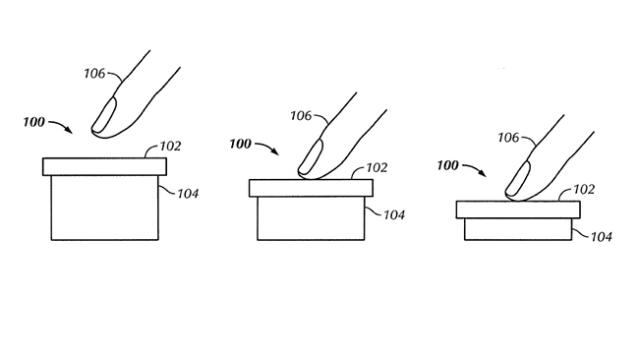Over the weekend, Bloomberg reported that Apple was working on enhanced sensors capable of detecting different levels of pressure. Now, an Apple patent for pressure-sensitive touchscreens could lend that rumour some credence.
The patent, unearthed by Apple Insider, describes a piece of hardware that can trigger different UI functions depending on how hard the user presses the glass of the screen. US Patent Number 8,581,870 — or “Touch-sensitive button with two levels” to its friends — appears to suggest that it’s actually about physical buttons, but dig a little deeper and it transpires that Apple is actually talking about technology that could be applied to a touchscreen coupled to an actuator. A “touch-sensitive depressible button,” as they put it.
The image above kinda shows that in action: A touch-sensitive button with “multiple depression thresholds.” As the button’s depressed, two or more thresholds can be reached, the device doing something different depending on which threshold is broken.
What’s that good for? Well, it could be an energy saving tactic. Imagine the first threshold as a hair trigger, where the merest touch activates touch-sensing. That would mean touch-sensing systems would only need powering up when the screen was touched, and not all the time, which would be super-neat.
Reaching an (only slightly higher) second pressure threshold might mean that a user’s finger is tracked and used as an input, while a third (higher) one might execute some kind of system command — like opening apps or changing volume. Really, the world’s Jony Ive’s oyster with this thing. But Apple Insider suggests one particularly cool idea:
[W]ith support for more than two threshold levels, the patent would be able to control a host of device functions. It can be imagined that a user would be able to turn on a device, locate and open a mail app, navigate to a message, reply and back out to the home screen, all controlled by minute changes in pressure. This “drilling down” into an app is not mentioned in the patent language, but is illustrative of the possibilities afforded by the invention.
Of course, it’s worth remembering that one report by Bloomberg and a patent don’t mean that you’re going to have an iPhone rocking this kind of technology any time soon. Indeed, even Bloomberg acknowledged that this might not become a marquee feature until 2015 at the earliest. A lot can happen between now and then, and like all patents and R&D, it’ll only to make it to market with Apple if, y’know, it’s actually good. But for the sake of some of that functionality, let’s hope it does. [USPTO via Apple Insider]
